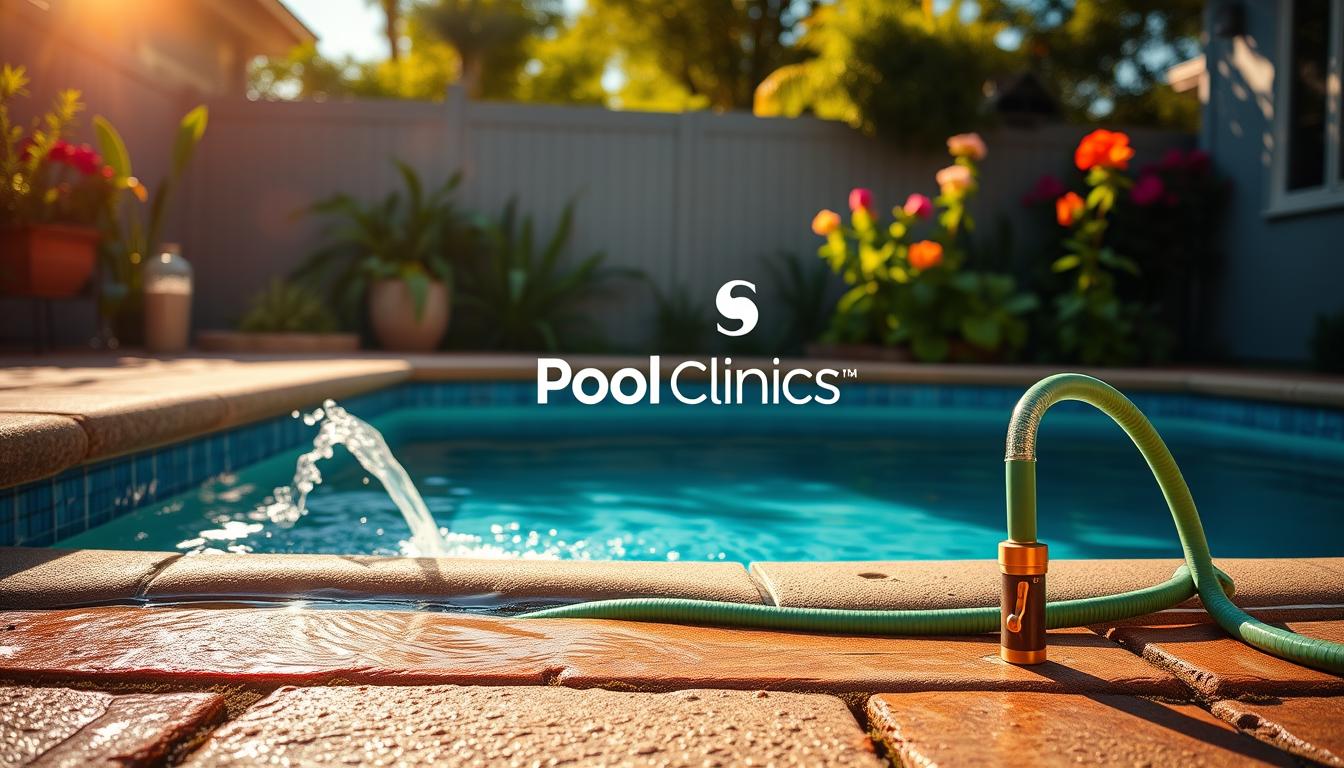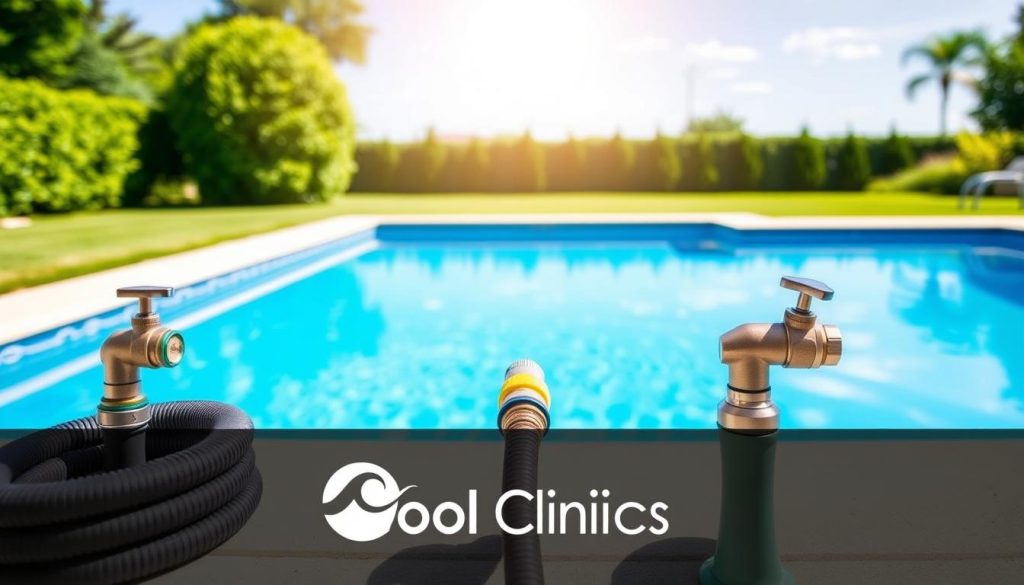
Pool owners often wonder how long it takes to fill their pool using a garden hose. The answer depends on pool volume, hose flow rate, and water pressure. These factors greatly impact the time it takes to fill your pool.
Consider a private swimming pool with a capacity of 80,000 liters. Using a typical garden hose delivering 60 liters per minute, it would take about 22.22 hours. That’s almost a full day of waiting for your pool to fill!
Imagine diverting a moderate-sized river with a flow rate of 5000 m^3/s into your pool. Your pool would be full in just 0.016 seconds. This scenario is unrealistic but shows how water flow rate affects filling time.
Most people use city water or well water to fill their pools. City water can take over 24 hours, while larger pools might need several days. Well water may contain more minerals like iron and copper.
These minerals in well water can potentially cause staining in your pool. It’s important to consider this when choosing your water source.
Key Takeaways:
- Pool filling time depends on pool volume, hose flow rate, and water pressure
- Filling an 80,000-liter pool with a 60 L/min hose takes approximately 22.22 hours
- City water can take over 24 hours to fill a pool; larger pools may require several days
- Well water may contain minerals that can cause staining in your pool
- Water delivery services offer a faster alternative but come at a higher cost
Factors Affecting Pool Filling Time
Several key factors impact how long it takes to fill a pool. Understanding these variables helps in making accurate pool size estimations. It also aids in using efficient pool filling methods to save water and time.
Pool Volume and Dimensions
A pool’s volume directly relates to its dimensions. Larger pools need more water and take longer to fill. Olympic-sized pools hold about 2.5 million liters.
Private pools’ capacities vary greatly depending on their size and depth. The bigger the pool, the more time it takes to fill.
Hose Flow Rate and Diameter
The hose’s flow rate is crucial in pool filling. A standard garden hose delivers about 24 liters per minute. This equals approximately 1,440 liters per hour.
Hose diameter also affects the flow rate. Wider hoses generally allow for faster water delivery. The right hose can significantly speed up the filling process.

Water Pressure and Source
Water pressure from the source influences pool filling time. Higher water pressure usually results in a quicker filling process. The water source could be a municipal supply or a private well.
Consider the water source and its pressure when estimating filling time. This helps in planning the pool filling process more effectively.
| Hose Diameter | Flow Rate (Liters/Minute) | Time to Fill 80,000 L Pool (Hours) |
|---|---|---|
| 1/2 inch (12.7 mm) | 30 | 44.44 |
| 5/8 inch (15.9 mm) | 60 | 22.22 |
| 3/4 inch (19.1 mm) | 90 | 14.81 |
Consider these factors to optimize the pool filling process. Use water conservation tips like pool covers to reduce evaporation. This helps minimize water waste and improves efficiency.
Knowing about pool size, hose specs, and water pressure is key. It allows for smarter decisions and more efficient pool filling methods.
Calculating Pool Filling Time
Knowing how long it takes to fill a pool is crucial. This knowledge helps us plan better. Let’s explore how to calculate pool filling time accurately.
Determining Pool Capacity
First, we need to find out the pool’s capacity. Measure the pool’s length, width, and average depth. Multiply these numbers to get the volume in cubic meters.
To convert cubic meters to liters, multiply by 1,000. This gives us the pool’s capacity in liters.
Measuring Hose Flow Rate
Next, measure the flow rate of your garden hose. Time how long it takes to fill a 5-gallon bucket. Divide the bucket’s volume by the time it took to fill.
This calculation gives you the flow rate in liters per minute. It’s essential for estimating the pool filling duration.
Estimating Filling Duration
Now, divide the pool capacity by the hose flow rate. The result is the estimated time in minutes to fill the pool. Convert to hours or days if needed.
| Pool Capacity (Liters) | Hose Flow Rate (Liters/Minute) | Estimated Filling Time (Minutes) | Estimated Filling Time (Hours) |
|---|---|---|---|
| 80,000 | 60 | 1,333.33 | 22.22 |
| 80,000 | 5,000,000 | 0.016 | 0.00027 |
Let’s look at an example. A pool holds 80,000 liters. A hose delivers 60 liters per minute. It would take about 22.22 hours to fill.
In contrast, a river flowing at 5,000,000 liters per second would fill the same pool in 0.96 seconds. This shows how water flow affects filling time.
Understanding pool filling calculations helps us plan better. We can prepare the right resources and time for our pool to be ready.
Tips for Efficient Pool Filling
Want to fill your pool faster? Use multiple hoses at once. This increases water flow and cuts down filling time. Connect two or more hoses to different water sources for best results.
Fill your pool during off-peak hours for better water pressure. Early morning or late evening works best. This avoids disrupting your neighbors’ water supply during busy times.
Save time and money by using a bulk water delivery service. They can quickly bring large volumes of water. You can then top off the pool with your garden hoses.
“An ounce of prevention is worth a pound of cure.” – Benjamin Franklin
Check your pool for leaks before filling. Small leaks can waste water and extend filling time. Inspect the pool’s structure, liner, skimmer, and return jets carefully.
Cover your pool while filling to reduce evaporation. This helps maintain water level and temperature. It’s especially useful in hot, dry conditions.
| Tip | Benefit |
|---|---|
| Use multiple hoses simultaneously | Increases total flow rate and reduces filling time |
| Fill during off-peak hours | Maintains good water pressure and avoids disrupting neighbors |
| Partner with bulk water delivery service | Saves time and money by partially filling the pool |
| Check for and fix pool leaks before filling | Prevents water waste and extends filling time unnecessarily |
| Cover pool during filling | Minimizes evaporation and conserves water, especially in hot and dry conditions |
Conclusion
Filling a pool with a garden hose takes time and patience. The process can last from a few hours to a couple of days. The pool’s size, hose flow rate, and water pressure all affect filling time.
Calculating pool capacity and hose flow rate helps estimate filling duration. This knowledge aids in planning and resource management. Using multiple hoses can speed up the process and save water.
Anyone can fill a pool with the right information and tools. Understanding key factors and applying practical strategies ensures success. With proper planning, filling a pool becomes a straightforward and rewarding task.







